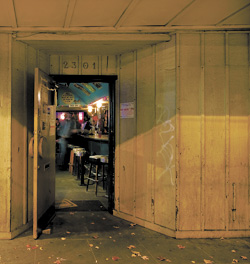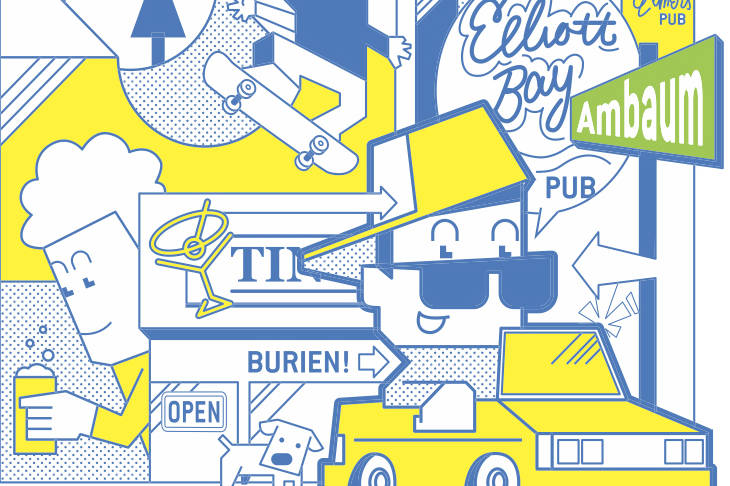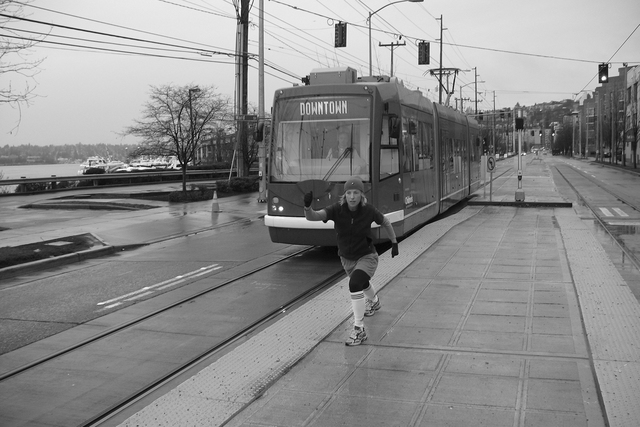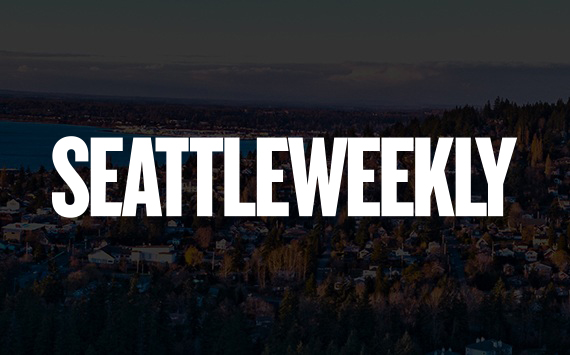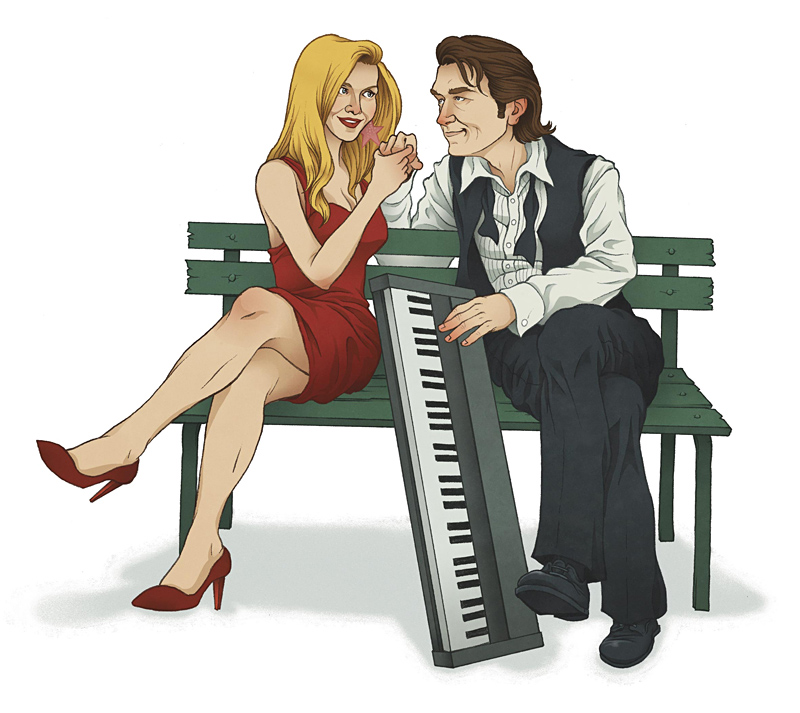Doc’s Pilchuck Tavern is situated on the banks of the Pilchuck River in Machias, a small Snohomish County town of about 1,000 where plodding tractors still create nine-car backups on a country road, and those impacted don’t bother honking. With a gravel parking lot out front and an unassuming facade, Doc’s serves only beer and wine at its carved-wood bar, but mostly just beer. The walls of the tavern’s bathrooms are covered in adult-magazine centerfolds, the ladies’ room a shrine to the male member. Outside, a chain-link fence separates Doc’s rectangular patio from the river and a flock of large geese, and an old black cat with leopard-print eyeballs (not fur, eyeballs) enjoys a sun break on a partly drizzly Saturday afternoon.
On the patio sits a table of half a dozen leathery regulars, pissing the day away, beer by beer, joke by joke. One of these individuals is a skinny man with sky-blue eyes named Ronnie, who begins shuttling kindling over to a fire pit in the middle of the concrete area. In a couple of hours, Ronnie says, a jump jazz band will set up its instruments next to a big-screen television that is currently airing a Pac-10 football game. Ronnie claims it’s about the best jump jazz band anyone will ever see, and all but insists that we stay for another pitcher or four.
Every New Year’s, Doc’s sponsors a polar bear swim in the river. Until his recent death, Seattle’s favorite pro sports cheerleader, Bill “the Beerman” Scott, was a regular participant in the event, and would drop by Doc’s whenever he could, despite the fact that he lived near the city. Ronnie’s eyes well up when he talks about Scott.
Doc’s is said to have been former Congressman Al Swift’s favorite place on earth. Evidently, the same went for Bill the Beerman. For some people, a place like Doc’s is the true American idyll.
As strictly defined, there is but one absolute in a tavern, and it’s a prohibition: no hard booze. Throughout the 20th century, that was fine. Rooted in Rainier and then Red Hook, Seattle had come to be regarded as the microbrew capital of the world; its barkeeps were long content to abide by restrictive state liquor laws requiring that establishments that wished to serve hard booze also sell a significant amount of chow. At one point, the law required a 70-30 food-to-drink sales ratio, a standard that’s been softened into oblivion over time.
To wit, since a relaxation of standards that began with state legislation enacted in 1997, and which has continued in recent years through subsequent Liquor Control Board maneuvers, Washington has adopted a laissez-faire approach to hard booze—and turned its back on beer. Nowhere has this tectonic shift been felt more poignantly than within the Seattle city limits, where a mere 40 taverns are still in operation, down from a tally of 161 in 1997. By contrast, the number of full liquor licenses has skyrocketed from 474 in 1997 to a current total of 830, thanks in part to a state-sanctioned loophole that defines overpriced TV dinners as “meals” and microwaves as “kitchens.” In fact, whereas not too long ago a full booze license was considered a premium commodity, it’s gotten so easy to obtain that a given establishment basically has to have a reason not to stock fifths of vodka behind the bar.
CHUGGING AT THE TUG
The Tug Tavern in West Seattle is one of these final 40. Aside from having a great moniker that nostalgically suggests Seattle’s maritime heritage, the Tug has a clientele that remains largely a mirror of the working-class South Delridge neighborhood it calls home. On a Friday night, shortly after 11, a dozen or so patrons shoot pool, needle one another playfully, and quaff cold, cheap beer in a manner largely foreign to hipper, cocktail-slinging haunts in more northerly reaches of town.
With a sound system unshackled from the whims of a head-bobbing DJ, the Tug’s patrons choose chestnuts by Stevie Ray Vaughan, Van Halen, and Journey on the tavern’s classic-rock-heavy jukebox. But then things get a little weird (in a good way); someone selects “Smooth Operator” by Sade. At the bar, a slightly rumpled guy who looks to be in his late 40s contorts his body into a slinky groove with the smooth-jazz beat, whereas before he’d been playing air organ to Boston’s “Long Time.” When a live version of Phil Collins’ “In the Air Tonight” comes on, the same guy holds his hands overhead, tapping a pair of imaginary drumsticks in time with the music before launching into an air-drum solo, à la that gorilla in the Cadbury commercial that’s become something of an Internet phenomenon.
So what’s this guy have to do with hard booze? Nothing—and that’s exactly the point. Had the Tug’s maestro of the air instrument been permitted to ingest, say, tequila during his hours-long set, he might have ended up blacked out or, worse yet, sleeping his bender off at a holding cell across the street in Southwest Precinct headquarters. For a certain type of slippery-slope drinker, taverns are, in and of themselves, a form of moderation, and their slow death reflects an oversight of sorts in a city whose public officials have been quibbling ineffectually for far too long over how to reduce drunken rowdiness. The elusive answer, it could be argued, is quietly vanishing before their very eyes. So, too, might be the city’s soul, forcing those who still seek it into the wilds of Machias for a countrified facsimile.
HARD UP AT THE MOON
With its virtually windowless exterior and beastly name, the Eastlake Zoo Tavern could easily be mistaken for a clandestine gay bar back when gay bars were considered taboo. But inside, the setup’s pretty straight: pool tables, darts, shuffleboard, peanuts, beer, taxidermy mounted on the walls, sports on TV, and the Rolling Stones on the speakers. In short, the Zoo is a dude den par excellence, and has been, unwaveringly, for more than 30 years, even as the neighborhood around it has taken an intensely highfalutin turn.
“I think you can still make money not serving hard alcohol; I’m not worried,” says Zoo manager Howard Brown. “People come in to play games and socialize. There’s something to be said about places where people are just drinking wine or beer. It’s more leisurely.”
This is what’s endeared Paul Zemann to places like the Zoo. By day, Zemann, a Woodinville resident and longtime Northwest tavern enthusiast who is currently contemplating a book on the topic, is a drug, alcohol, and tobacco treatment specialist for King County. By night, he kicks back and sips beer at taverns countywide. Nothing about this apparent conflict causes Zemann the slightest bit of uneasiness.
“My passion for taverns is not the alcohol,” says Zemann, a mustachioed walrus of a man who recently reunited with his high-school cover band at a 30th reunion in his native Missouri. “It’s the ‘third place’ principle. At a restaurant, you’ve got your family—but you come to the tavern and you’re with the crowd. People aren’t here slamming them down. Beer and wine, it doesn’t make you drunk as fast; it’s hanging out, chatting with your friends. The point is not to get drunk, it’s to drink socially and have a conversation.”
The Blue Moon Tavern’s nettlesome quest for a full liquor license is viewed by purists as a watershed moment in the liquoring up of Seattle. Since 1934, the historic U District tavern had stuck to a duo of beer and wine to sate a dynamic cadre of ultra-bohemian regulars, which included a revolving cast of writers, artists, politicians, academics, clock-punchers, street gypsies, and the occasional Pulitzer Prize winner. But last year, co-owner Gus Hellthaler decided to seek a full liquor license, a maneuver that touched off a showdown with city administrators that threatened the tavern’s very existence. Ultimately, Hellthaler reached détente with the city attorney’s office, and quietly obtained a license to serve hard booze at the Moon earlier this year.
Though the great La Conner novelist Tom Robbins, a former Moon regular who’s been instrumental in past efforts to save the establishment, is thrilled at his comrade Hellthaler’s prospect for hundred-proof prosperity, he finds the Moon’s boozy evolution to be bittersweet.
“I think, for one thing, [hard booze at the Moon] is going to affect—and maybe eliminate—a lot of the conversation,” says Robbins. “You can discuss art and politics for hours on end over pitchers of beer and remain relatively coherent; there’s even a time early on when you’re more eloquent than normal. But most people can’t drink a lot of whiskey and remain conversant in any sort of entertaining and intellectually stimulating sort of way.”
But then Robbins hedges a bit. “It’s hard to say: The clientele at the Blue Moon are not typical human beings,” he says. “They may be able to drink whiskey there and maintain some soulfulness. But if they do, they’re certainly the exception to the rule.”
Herein, Robbins is just getting warmed up, using the Moon’s ordeal to launch into a textured diatribe on the superiority of beer. “Cocktails are elegant and sophisticated, and there’s a place for elegance and sophistication, but cocktails have no soul. Beer has a greater connection to the earth and to the fields—to agrarian culture—than do harder spirits.
“You have the yeast in beer, and the air is full of yeast spores,” Robbins continues. “Right now, you’re breathing yeast spores, and so am I. Yeast is a fungus, and related to mushrooms. Those spores might have drifted down from other solar systems; they are biologically capable of that. So they’re simultaneously subterranean and extraterrestrial. You can’t say that about gin.”
Sipping Old Overholt in a booth toward the rear of the Moon on a recent Tuesday night, Hellthaler takes a decidedly different tack, dismissing the notion that taverns should be confined to beer and wine. “I reject the idea that the state liquor board’s definition of a tavern fits the definition of tavern in the rest of the United States,” says Hellthaler, a Detroit native and carpenter by trade who can hold his own conversationally with the likes of Robbins. “Washington was the first state I couldn’t walk into a working-class bar and get a shot. [The delineation of licenses] shouldn’t exist. You can either sell alcohol or you can’t.”
As for how hard booze has impacted the Moon since its license upgrade, Hellthaler insists the status quo has held firm—attitudinally, anyway. “The way business has been since we got the license, it may get back to where it was before the smoking ban,” he says. “But we still sell mostly beer.”
Mike Semandiris’ family has run Mike’s Chili Parlor in Ballard since 1939. Until 2005, the business operated strictly as a tavern. But since adding a handful of more potent bottles behind the bar—paramount among them an ample supply of ouzo, a Greek elixir that the very Greek owners serve with an ice cube—Semandiris says, “I don’t think the complexion of the business has changed significantly, [but] I do think that groups of people come in that may not have come in previously because we have liquor.”
HOWLING AT THE POUND
With a tight top, freshly tanned lower back, and blond streaks in her salon-styled hair, the bartender at the T-Bird Tavern on Crown Hill is attractive in a let’s-not-bring-her-home-to-mom sort of way. Considering that the T-Bird shares a wall with the neighboring Sands strip club, this is appropriate. It’s also the best informal good-neighbor agreement that can be found in the city, considering strip joints in Seattle can’t serve alcohol. It’d really be a mutually beneficial relationship if there were more patrons in either the Sands or the T-Bird.
“My location here is one of the problems,” says T-Bird owner Bob Glover, who recently put his tavern on the market. “There aren’t a lot of young people around, and that’s what it takes to keep in business these days. The fishing industry is kind of dropping also,” he adds, suggesting that the T-Bird saw better days back when the greater Ballard area was more reliant upon the sea for sustenance.
Outside, a steady rain pours down amidst early autumn’s first true chill. On a television set above the bar, the Boise State football team is whupping Southern Miss on the former squad’s home Smurf Turf. A 48-year-old construction worker who looks like a cross between Bret Michaels and Travis Tritt takes a break from a casual game of pool to sit down at the bar, where he orders a pitcher of domestic lager and summons his two dogs. As he fills his pint glass, a smaller dog comes out of a back room, and soon finds the nose of a fourth dog lodged up his ass.
“It’s like a dog pound in here,” remarks the bartender, although it obviously doesn’t bother her. This is one of the reasons why the construction worker comes here: The T-Bird is dog-friendly. The other reason: He just had a vasectomy and can’t consume anything stronger than beer in concert with the medication he’s been prescribed.
Like Michaels and Tritt, the construction worker has played in several bands over the years, and cops to living the ’80s “to the fullest,” which probably explains the fact that he’s sired four children by four different women (hence the vasectomy). While he has a place in what he describes as a really sketchy neighborhood off Highway 99 near the Boeing plant in Everett, he’s currently working on a building in Lower Queen Anne, and has been living out of the back of his Ford Explorer for convenience’ sake. It’s not all that bad a setup, he insists. The air mattress he sleeps on is just as comfortable as his bed; he’s got a small dresser for his clothes; and his dogs, both of whom he adopted after they were abandoned by their previous owners, keep him safe. Sometimes he even parks his vehicle in the T-Bird’s 15th Avenue lot for the night.
GIVING A SCHMIDT
For those unfamiliar with Seattle’s greatest multidirectional thoroughfare, shortly after 15th passes 85th Street, it becomes Holman Road. At Greenwood Avenue North—the Rickshaw being one landmark of note here—Holman morphs into North 105th Street (further east, it becomes Northgate Way). On this road, equidistant from the Rickshaw and Cyndy’s House of Pancakes on Aurora, sits a diminutive watering hole called Van’s 105 Tavern.
What’s most striking about Van’s is how bright it is inside, a beacon of light in a relatively hardscrabble, poorly illuminated North Seattle neighborhood. Rockabilly quietly plays on the jukebox, and the Mariners replay on FSN is tuned in on the TV, which an aging war veteran named Art, wearing a Marine Corps hat, watches intently while drinking a can of Schmidt.
Seated near Art is a much younger, larger fellow named Galen, who drinks beer straight from a mini-pitcher and flips the female bartender a ton of good-natured shit. When another young lady enters the tavern, accompanied by a skinny, handsome guy, Galen asks her if she’s ever been married. She replies that she’s had several husbands, but only one of them has been rich.
After finishing his beer, Art gets up and wobbles around a bit before heading to the men’s room. When he comes back, he orders another Schmidt, prompting Galen to pick up the tab. The couple that’s just entered asks to have the volume on the jukebox turned up a bit, but only if it’s OK with Art. He says that the volume can be turned up slightly, so long as he can still hear the Mariners telecast.
Galen then launches into a balanced critique of the Reagan presidency, commending the Gipper for staring down the Russians during the Cold War, but skewering him for his decision to snub the air traffic controllers’ union. Here, Galen goes so far as to finger this standoff as being responsible for “the death of the middle class,” pointing out that to qualify as middle class in Seattle nowadays, you have to pull down a six-figure income—which brings us back to Robbins.
“Taverns were the haunt of the workingman,” says the author. “Part of that was the economic factor: It’s simply cheaper than hard liquor. But most of it was due to the authenticity. Even bohemians want to drink champagne nowadays. It’s part of the gentrification that is reducing the soul of Seattle, and gentrification is tied to upward mobility.”
SWEEPING UP THE SAWDUST
Restricting itself to a 21-and-over crowd despite the fact that it serves pizza to make the most finicky fifth-grader drool, the Northlake Tavern might boast the most puzzling modus operandi of the final 40. If they’re only going to allow adults in the door, why no liquor, considering they’ve long had a full menu of food? Conversely, if they’re going to restrict themselves to beer and wine anyway, why not be more family-friendly with the admission policy?
“Pizza and beer, they go together; that’s what people expect,” says owner Cheryl Berkovich, before offering an explanation for why her Lake Union establishment doesn’t vie for a full spirits license. “My liability insurance would probably triple if I had hard liquor in here. And I think people would get a little bit rowdier.”
Alan Marlatt, a professor of clinical psychology at the University of Washington, is one of the nation’s foremost advocates of harm reduction: He favors individualized treatment of alcoholism—which, for some patients, means they can still drink—over a cold-turkey approach (which Marlatt isn’t opposed to in extreme cases). “If someone’s been drinking too much tequila, we want to switch them to something with lower alcohol content, like beer or wine,” says Marlatt. Not surprisingly, Marlatt’s open-minded philosophy has made him public enemy No. 1 for the megabucks 12-step industry, which has attempted to discredit his findings at every blurry fork in the road.
When Marlatt was growing up in British Columbia, the prevailing wisdom was that alcoholism was purely biological. This mind-set has evolved over time to include environmental factors, thanks in part to Marlatt’s fieldwork. And if Marlatt were permitted to design his perfect drinking environment, it would probably look a lot like the Northlake.
“The fact that there’s just beer and wine is a good effect because they’ve got food and the alcohol content is going to be lower,” he says. “The risk of running up a higher blood-alcohol level is greater in bars. [The Northlake] has all the qualities of a safe environment.”
Marlatt’s not much of a beer or hard-booze man himself. Seated at a table near the bar at the Northlake—which, with its mural-covered walls and checkered vinyl tablecloths, resembles a Little League party for adults—Marlatt pokes at an antipasto salad and sips white wine before launching into a lengthy anecdote from his formative years in Canada.
“I grew up in B.C., where they had beer parlors. You could only drink beer, and there was no food,” Marlatt begins. “They were separated by gender: one side was gentlemen only; the other side was ladies and their escorts. On the men’s side, there was sawdust on the floor because the men would drink so much that they would throw up on the floor. The women and their escorts would be under control. It was the perfect place to conduct alcohol studies.”
“[The beer parlors] were designed to keep people from drinking too much, but it backfired,” Marlatt continues. “At closing time, you could order as many beers as you wanted, but you had to leave by 11. It would lead to a lot of chugalugging, and fights would break out in the streets. Finally, the city council said, ‘We’ve got to change this.'” They did away with gender stratification, and the parlors were henceforth permitted to serve food, which Marlatt testifies did the trick.
While the mayor and Seattle City Council have sought, in effect, to seize a chunk of regulatory power from the state Liquor Control Board in an unsuccessful effort to clamp down on the city’s supposedly troublesome nightlife environment, there’s one tactic they haven’t yet tried: proactively tweaking the nature of what drinking establishments can and cannot serve. (In fairness, that could be because the booze train was already too far down the tracks once the city decided to tackle the issue.)
“It hasn’t entered any of the conversations that I’ve been a part of,” says City Council member Sally Clark, when asked whether the council has considered trying to convince certain establishments to revert to a beer-and-wine-only license. “It’s an economic issue.”
Still, Clark, who’s been the council’s point person on the proposed nightlife ordinance, acknowledges the merit in such an approach. “Is [just drinking beer or wine] a slower, less destructive burn? I think there’s something to that,” she says. “When I think about where to talk about the viaduct, it’s not the big old bar with the cruise scene. I think about a place like the Columbia City Ale House.”
Clark’s tavern of choice, the Columbia City Ale House, has been hailed by many neighborhood revivalists as being a pioneer business in the formerly desolate Rainier Avenue burg’s renaissance. It has, as Clark suggests, become a popular after-hours meeting place for politicians and community leaders, with way healthier-than-average pub fare, that lives up to its sterling rep as southerly kin of the 74th Street Alehouse, also one of the final 40..
CELEBRATING THE MOMENTS
A mere eight blocks south of the alehouse sits Mel’s Tavern. Mel’s neighborhood, Hillman City, is but a stone’s throw from the wave of prosperity that’s transformed Columbia City into a multiracial Wallingford. But this wave has yet to reach Mel’s doorstep—and it shows.
Mel’s can adequately be divided into thirds: one-third dank pool room, one-third dingy beer counter, and one-third supply closet, with popcorn carts, cookers, and miscellaneous machinery strewn about. That said, the elderly bartender is plenty nice, explaining to all but one of his four customers that his kids live in Florida now on account of Seattle’s perennially crummy weather. After a Raul Ibanez homer gives the Mariners the lead on an overhead TV, a tall, bearded, slightly inebriated man wanders over to the bar for one last pop. The bartender asks him if he’s driving home. The man says he isn’t—enough to earn him another pour.
The one person who keeps to himself is a fellow who looks to be of Pacific Islander descent. He’s sipping beer and watching the Discovery Channel on a TV hinged to Mel’s northernmost wall. Abruptly, the man gets up and walks over to the jukebox, which may or may not be operational. But he has no interest in selecting songs, instead breaking out a digital camera and snapping flash photos of his fellow patrons.
What is at first amusingly odd quickly grows creepy, as the man seems to be focusing his efforts on the lone female patron, and refuses to respond to polite queries about how he intends to use the images he’s capturing. When this woman gets up to exit the tavern with her boyfriend, the man with the camera follows. The boyfriend tells him to knock it off, before leaving the building and heading toward his vehicle. After he starts his engine, out pops the man with the camera from a back alley situated behind Mel’s, snapping photos until the car is well out of sight.
A mile and a half further down Rainier is the Wildwood Tavern, an establishment that appears out of place even when set against the bric-a-brac aesthetic of that particular portion of the Southeast Seattle strip. With its No. 8 Dale Earnhardt pennants flapping in the wind above a gravel parking lot, it looks and feels like a rural southern Illinois roadhouse—at least until one sits down at the bar on a midweek afternoon.
The Wildwood’s bartender is of Middle Eastern descent. As he flips the television sets from an old action movie on TNT to the final game of what would turn out to be a meaningless Mariners sweep of the A’s, a Caucasian gentleman enters and begins draining quarters from a video game called Maximum Force. Shortly thereafter, a Filipino guy comes in and orders a bottle of Bud—to go. Then enters a white retiree named Dick, who orders himself a $1.50 schooner of Busch and asks the quarter collector, who looks to be getting on in years, when he’s planning on retiring. He responds that he’s 58, and is looking forward to the time when he can sit around all day and drink beer like Dick.
JUMPING OFF THE BANDWAGON
These are all scenes from a protracted funeral. Five years from now, urban beer halls like the Sloop, Fiddler’s Inn, Red Onion, Chuck & Sally’s, the Highliner, the Sundown, the Streamline, the Pioneer Square Saloon, and the Alki Tavern may be ablaze in an inferno of flaming Dr. Peppers, their golden-foamed foundations a mere cog in the booze-fueled money machine.
“One of the problems with just having beer and wine is the hard liquor seems to bring in more females at night,” says Tim Sullivan, owner of Sully’s Snowgoose Saloon. “I have people who get up and leave when I tell them I don’t have hard liquor.”
“[The trend toward full liquor licenses] makes everybody think that everybody’s going to jump on the bandwagon,” says Donna Morey, who owns Fremont’s Buckaroo Tavern (her husband and business partner, Keith, passed away not too long ago). “Simply because I’m older, I probably will sell in the next 10 years. For the time being, we’re holding out as a beer-and-wine tavern. That is our hope: that we can hold out at least until I’m no longer around.
“We’ve been a tavern for 70 years,” Morey adds. “So we’re going to try to keep with our ordinary traditions we’ve always run on—wine and beer and good cheer.”
Wherever he is now, Bill Scott would raise a glass to that.
Halley Griffin contributed to this report.
